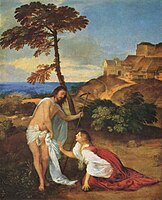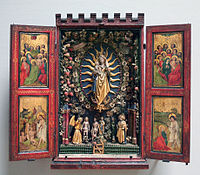Noli me tangere

Noli me tangere ('touch me not') is the Latin version of a phrase spoken, according to John 20:17, by Jesus to Mary Magdalene when she recognized him after his resurrection. The biblical scene gave birth to a long series of depictions in Christian art from Late Antiquity to the present.[1][2] The original Koine Greek phrase, Μή μου ἅπτου (mḗ mou háptou), is better represented in translation as "cease holding on to me" or "stop clinging to me", i.e. an ongoing action, not one done in a single moment.[3]
Interpretation[]
According to Maurice Zundel (1897–1975), in asking Mary Magdalene not to touch him, Jesus indicates that once the resurrection is accomplished, the link between human beings and his person must no longer be physical, but must be a bond of heart to heart. "He must establish this gap, she must understand that the only possible way is faith, that the hands can not reach the person and that it is from within, from within only, that the we can approach Him."[4] Likewise, later, when Thomas reached out to touch the wounds of Jesus, he declares: "blessed are those who have not seen and yet have believed" [John 20:29] because "He knows it is useless."[4]
Christians of Western catholic tradition, namely Roman Catholics, Lutherans, and Anglicans, would say this statement is to be received in relation to the Ascension of Jesus, that because he had not yet ascended to the right hand of God, it was more of a "not yet" statement rather than a "never" cling to me. Jesus became incarnate for the sake of mankind and is explicitly stated to retain his human body. When Jesus ascended to the right hand of the Father, he then "fills all things" (e.g. Eph. 1:23), and can properly be clung to in the means of grace he provides, such is in the Eucharist.
Liturgical use[]

The words are a popular trope in Gregorian chant. The supposed moment in which they were spoken was a popular subject for paintings in cycles of the Life of Christ and as single subjects, for which the phrase is the usual title.
In the Eastern Orthodox Church, the Gospel lesson on Noli me tangere is one of the Twelve Matins Gospels read during the All Night Vigil on Sunday mornings.
Echoes[]
In medicine[]
In medicine, the words were occasionally used to describe a disease known to medieval physicians as a "hidden cancer" or cancer absconditus, as the more the swellings associated with these cancers were handled, the worse they became.[5]
The phrase or a paraphrase in the vernacular is often drilled into surgical students regarding organs of the body that are notoriously delicate or prone to develop complications if disturbed; up through the early half of the 20th century, the most common invocation of this phrase concerned the heart.[citation needed] In current times,[when?] the organ considered most deserving of the phrase is typically the pancreas; the maxim "eat when you can, sleep when you can, don't mess with the pancreas" is commonly found in surgical anecdotes.[citation needed]
Botany[]
The touch-me-not balsam is known by the binominal name Impatiens noli-tangere; its seed pods can explode when touched, dispersing the seeds widely.[6] Hibiscus noli-tangere has sharp glass-like needles that detach from its leaves when touched.[7]
In culture and literature[]
The expression found its way into culture and literature. Following Petrarch,[8] in the lyric poem "Whoso list to hunt" the 16th-century poet Sir Thomas Wyatt, mentions a hind who stands for the elusive lover hunted (metaphorically) by the speaker, with an inscribed collar: "There is written, her fair neck round about: / Noli me tangere, for Caesar's I am".[9] The idea probably originates in a story of Pliny the Elder about deer of "Caesar", which lived 300 years and had collars with the inscription,[10] perhaps related to one of Solinus (fl. 3rd century AD) about Alexander the Great collaring deer, who then survive 100 years, though no inscription on the collars is mentioned.[11]
The phrase was also used as the title for José Rizal's book criticizing the Spanish colonization of the Philippines. The phrase evokes a cancer of the eyelids, for which ophthalmologists used the phrase; it symbolizes the people's blindness to the ruling government, which Rizal deemed the social cancer that people were too afraid to touch.
The thirteen-hour version of the experimental film Out 1 (1971) is sometimes subtitled Noli Me Tangere, as an ironic reference to it being the uncut version favoured by the director Jacques Rivette (as opposed to the edited version, Out 1: Spectre, which is "only" four hours long).[12]
In American history and military[]


Historically, the phrase was used by Revolutionary-Era Americans in reference to the Gadsden flag—with its derivation "don't tread on me"[13]—and other representations dating to the American War for Independence.[14] In the United States military, the phrase is the motto of the US Army's oldest infantry regiment, the 3rd U.S. Infantry Regiment (The Old Guard), located at Fort Myer, Virginia; the snake symbol can be found in the coat of arms of the 369th Infantry Regiment, known as the Harlem Hellfighters. "Don't tread on me" is also used to the First Navy Jack of United States Navy. It is used to the motto of No. 103 (Bomber) Squadron, Royal Air Force. Also the motto of the U.S Army 4th Infantry Regiment located in Hohenfels Germany.
Relic[]
A piece of forehead flesh covered by skin, previously attached to Mary's alleged skull, is kept in the cathedral of Saint-Maximin-la-Sainte-Baume in southern France. The relic is purported to be from the spot above Mary's temple touched by Jesus at the post-resurrection encounter in the garden.[15][16]
Artistic representation[]
The biblical scene of Mary Magdalene's recognizing Jesus Christ after his resurrection became the subject of a long, widespread and continuous iconographic tradition in Christian art from Late Antiquity until today.[2][1] Pablo Picasso, for example, used the c. 1525 painting Noli me tangere by Antonio da Correggio, stored in the Museo del Prado, as an iconographic source for his 1903 painting La Vie (Cleveland Museum of Art) from the so-called Blue Period.[17]

Noli me tangere fresco by Fra Angelico
Noli me tangere by Martin Schongauer

Noli Me Tangere, by Fra Bartolomeo c. 1506

Noli me tangere by Titian c. 1511–1515
Noli me Tangere by Hans Holbein the Younger, 1524.

Appearance of Jesus to Mary Magdalene after resurrection, Alexander Ivanov, 1835

Touch Me Not (Noli me tangere) by James Tissot

Mary of Magdala at the empty tomb window at St. Matthew's Lutheran Church. Attributed to the Quaker City Glass Company of Philadelphia, 1912
According to Christian tradition, the Noli me tangere took place in what is now the Chapel of John the Baptist adjacent to the Church of the Holy Sepulchre, Jerusalem
Hortus Conclusus triptych, Royal Museum of Fine Arts Antwerp
See also[]
- Life of Jesus in the New Testament
- Post-resurrection appearances of Jesus
- Noli Me Tángere (novel)
- Noli me tangere casket
- Nemo me impune lacessit – "no one assails me with impunity"
References[]
- ^ Jump up to: a b See G. Schiller, "Ikonographie der christlichen Kunst", vol. 3, Auferstehung und Erhöhung Christi, Gütersloh, 2 1986 (ISBN 3-579-04137-1), pp. 95–98, pl. 275–297
- ^ Jump up to: a b Art. Noli me tangere, in: "Lexikon der christlichen Ikonographie", vol. 3 Allgemeine Ikonographie L–R, Rom Freiburg Basel Wien, 1971 (ISBN 3-451-22568-9), col. 332–336.
- ^ See, for instance, "Touch Me Not" by Gary F. Zeolla or Greek Verbs. In fact the form of the verb used is not the aorist imperative, which would indicate momentary or point action, but the present, which indicates an action in progress (Lesson Five – Greek Verbs). When, later in the same chapter, Jesus invites Thomas to touch his side, the aorist imperative is used to indicate the proposed momentary action (John 20:27). See also Jeremy Duff, The Elements of New Testament Greek, 7.2.2. "The difference between the Present and Aorist Imperatives".
- ^ Jump up to: a b Zundel, Maurice, Silence, parole de vie, transcription of a speech given in 1959, published by Anne Sigier, 1990, p. 129.
- ^ Wallis, Faith. "Medieval Medicine: A Reader". University of Toronto Press, 2010, p. 345 ISBN 978-1442601031
- ^ "British Wild Plant: Impatiens noli-tangere Touch-me-not Balsam". www.ukwildflowers.com.
- ^ Farmer, Edward E. (May 1, 2014). "Leaf Defence". OUP Oxford – via Google Books.
- ^ The Bible in Shakespeare, by Hannibal Hamlin, p. 79
- ^ Rumens, Carol (10 August 2009). "Poem of the week: Whoso List to Hunt by Thomas Wyatt". London: The Guardian. Retrieved 26 May 2011.
- ^ Easthope, Antony, Poetry and Phantasy, 1989, Cambridge University Press, ISBN 0521355982, 9780521355988
- ^ Solinus, Polyhistor, 19:18
- ^ "Out 1: Noli Me Tangere review – 13-hour art film is a buff's ultimate challenge". the Guardian. October 28, 2015.
- ^ Shipley 2001, p. 400
- ^ Cannon Jr. 1991, p. 38
- ^ Flayol, Veronique, Magdalene and the "Noli me tangere", 11 April 2020, accessed 25 July 2020
- ^ Lawlor, Paula, Skull of Mary Magdalene, MagdalenePublishing.org, 11 April 2020, accessed 25 July 2020
- ^ Gereon Becht-Jördens, Peter M. Wehmeier: Picasso und die christliche Ikonographie. Mutterbeziehung und künstlerische Position. Reimer, Berlin 2003, esp. pp. 39–42, fig. 1–4. ISBN 3-496-01272-2.
Bibliography[]
- Bieringer, R; B. Baert; K. Demasure. 2016. "Noli mi tangere" in interdiciplinary perspective. Bristol, CN: Peeters.−
- Cannon Jr., Devereaux D. (1991), The Flags of the Confederacy: An Illustrated History, St. Lukes Press, ISBN 978-0918518637
- Shipley, Joseph Twadell (2001), The Origins of English Words: A Discursive Dictionary of Indo-European Roots, The Johns Hopkins University Press, ISBN 978-0801830044
External links[]
| Look up Noli me tangere in Wiktionary, the free dictionary. |
| Wikimedia Commons has media related to Noli me tangere. |
- Eastern Christian liturgy
- Gospel of John
- Iconography of Jesus
- Latin religious words and phrases
- Liturgy of the Hours
- Mary Magdalene
- Sayings of Jesus
- Vulgate Latin words and phrases
- Paintings of Noli me tangere











